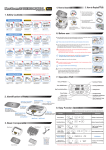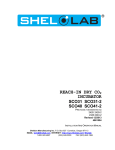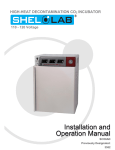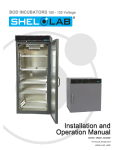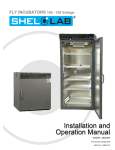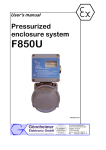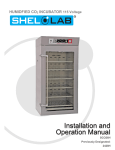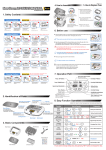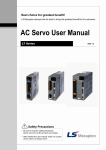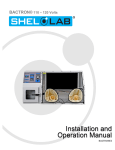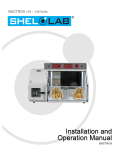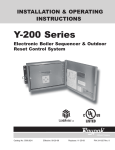Download operation (continued)
Transcript
AIR-JACKETED CO2 INCUBATORS 115 Volts Installation and Operation Manual SCO58 SCO40 SCO31 Previously designated: 2460, 2440, 2428 AIR-JACKETED CO2 INCUBATORS 115 Voltage Installation and Operation Manual Part Number (Manual): 4861710 Revision: December 24, 2014 Pictured on front cover: SCO58 SCO40 SCO31 These units are compliant with the following standards for use within an ambient air pressure range of 22.14 – 31.3 inHg (75 – 106 kPa), with no flammable, volatile, or combustible materials being heated. CAN/CSA C22.2 No. 61010-1:2012 CAN/CSA C22.2 No. 61010-2-010 + R:2009 UL 61010A-2-010:2002 UL 61010-1:2012 EN 61010-1:2010 EN 61010-2-010:2003 2|Page TABLE OF CONTENTS INTRODUCTION........................................................................................................................................... 4 General Safety Considerations ................................................................................................................. 4 Engineering Improvements ....................................................................................................................... 5 Contacting Assistance ............................................................................................................................... 5 RECEIVING YOUR INCUBATOR ................................................................................................................ 6 Inspecting the Shipment ............................................................................................................................ 6 Recording Data Plate Information ........................................................................................................... 10 INSTALLATION .......................................................................................................................................... 11 Ambient Conditions ................................................................................................................................. 11 Location ................................................................................................................................................... 11 Power Source .......................................................................................................................................... 11 Lifting ....................................................................................................................................................... 12 Leveling ................................................................................................................................................... 12 Access Port Stopper ............................................................................................................................... 12 Connect the CO2 Supply to the Incubator ............................................................................................... 13 Shelving Installation ................................................................................................................................ 14 Cleaning and Deionized Water ............................................................................................................... 15 GRAPHIC SYMBOLS ................................................................................................................................. 16 CONTROL PANEL OVERVIEW ................................................................................................................. 18 OPERATION ............................................................................................................................................... 20 Theory of Operation ................................................................................................................................ 20 Preparing the Incubator ........................................................................................................................... 22 Set the Temperature Set Point ................................................................................................................ 23 Calibrate the Temperature display .......................................................................................................... 24 Set the Over Temperature Limit .............................................................................................................. 26 Muting the Audible Temperature Alarm .................................................................................................. 27 Set the CO2 Set Point.............................................................................................................................. 27 Calibrating the CO2 Display ..................................................................................................................... 28 Muting the Audible CO2 Alarm ................................................................................................................ 31 No Gas Supply Alarm (NGS) .................................................................................................................. 31 Loading the Incubator ............................................................................................................................. 32 Attaching equipment to the Interior Accessory Outlets ........................................................................... 32 Data Output Capabilities ......................................................................................................................... 33 USER MAINTENANCE ............................................................................................................................... 34 Cleaning and Disinfecting ....................................................................................................................... 34 Maintaining Atmospheric Integrity ........................................................................................................... 35 Electrical Components ............................................................................................................................ 35 Condensation and the Dew Point ............................................................................................................ 36 UNIT SPECIFICATIONS............................................................................................................................. 37 Weight ..................................................................................................................................................... 37 Dimensions .............................................................................................................................................. 37 Capacity .................................................................................................................................................. 37 CO2 .......................................................................................................................................................... 38 Temperature ............................................................................................................................................ 38 Power ...................................................................................................................................................... 38 PARTS AND CONSUMABLES .................................................................................................................. 39 3|Page INTRODUCTION Thank you for purchasing a Sheldon SCO Series Air-Jacketed CO2 Incubator. We know that in today’s competitive marketplace, customers have many choices when it comes to constant temperature equipment. We appreciate you choosing ours. Our continued reputation as a leading laboratory product manufacturer rests with your satisfaction. Sheldon Manufacturing, Inc. stands behind our products, and we will be here if you need us. These CO2 incubators are intended for professional, industrial, or educational cell cultivation applications. They are not designed for use in hazardous or household locations. Before using the incubator read the entire manual to understand how to install, operate, and maintain the incubator in a safe manner. Keep this manual available for use by all incubator operators. Ensure that all operators are given appropriate training before the incubator begins service. GENERAL SAFETY CONSIDERATIONS Note: Failure to follow the guidelines and instructions in this manual may create a protection impairment by disabling or interfering with the unit’s safety features. This can result in injury or death. Your Shel Lab CO2 incubator and its recommended accessories are designed and tested to meet strict safety requirements. Only use this equipment for its intended application. Any alterations or modifications void the warranty. For continued safe operation of your incubator always follow basic safety precautions including: Follow all local ordinances in your area regarding the use of this incubator. If you have any questions about local requirements, please contact the appropriate local agencies. The power supply for the unit must be an earth grounded electrical outlet that conforms to national and local electrical codes. If the incubator is not grounded properly, parts such as knobs and controls can conduct electricity and cause serious injury. Always use the power cord supplied with the unit or an identical replacement cord. Avoid damaging the power cord. Do not bend it excessively, step on it, or place heavy objects on it. A damaged cord can be a shock or fire hazard. Never use a power cord if it is damaged. Position the unit so that the user can quickly unplug the cord in the event of an emergency. Use only approved accessories. 4|Page INTRODUCTION (CONTINUED) ENGINEERING IMPROVEMENTS Sheldon Manufacturing continually improves all of its products. As a result, engineering changes and improvements are made from time to time. Therefore, some changes, modifications, and improvements may not be covered in this manual. If your unit’s operating characteristics or appearance differs from those described in this manual, please contact your Shel Lab dealer or distributor for assistance. CONTACTING ASSISTANCE If you are unable to resolve a technical issue with your incubator, please contact Sheldon Technical Support. Phone hours for Sheldon Technical Support are 6am – 4:30pm Pacific Coast Time (west coast of the United States, UTC -8). Please have the following information ready when calling or emailing Technical Support: the model number and the serial number (see page 10). EMAIL: [email protected] PHONE: 1-800-322-4897 extension 3, or (503) 640-3000 FAX: (503) 640-1366 Sheldon Manufacturing INC. P.O. Box 627 Cornelius, OR 97113 5|Page RECEIVING YOUR INCUBATOR Before leaving our factory, all SCO Incubators are packaged in high-quality shipping materials to provide protection from transportation-related damage. When the unit departs the factory, safe delivery becomes the responsibility of the carrier. Damage sustained during transit is not covered by the incubator warranty. This makes it important that you inspect your SCO Incubator for concealed loss or damage to its interior and exterior when receiving it. If you find any damage to the unit, follow the carrier’s procedure for claiming damage or loss. The orientation photos on the following pages may serve as a useful visual guide for inspections. INSPECTING THE SHIPMENT Carefully inspect the shipping carton for damage. Report any damage to the carrier service that delivered the incubator. If the carton is not damaged, open the carton and remove the contents. The unit should come with an Installation and Operation Manual, warranty card, and a Certificate of Compliance. Verify that the correct number of the following accessories are present: Included Accessories Model CO2 Tubing Kit Shelves Shelf Clips 115V Power Cord SCO58 1 6 36 1 SCO40 1 6 24 1 SCO31 1 6 24 1 Carefully check all packaging before discarding. Save the shipping carton until you are sure everything works properly. 6|Page RECEIVING YOUR INCUBATOR (CONTINUED) Orientation Photos SCO58 Control Panel CO2 Inlet (left) CO2 Sample Port (right) Data Ports Power Inlet Circuit Breaker Access Port OTL Temperature Probe (Top) Controller Board Temperature Probe (Bottom) Incubation Chamber Back Wall Shelf Mounting Standard Door Gasket Incubator Door 7|Page RECEIVING YOUR INCUBATOR (CONTINUED) SCO40 CO2 Inlet CO2 Sample Port Data Jacks USB-Style Port Control Panel OTL Temperature Probe (Top) Main Temperature Probe (Bottom) Incubation Chamber Power Inlet, Circuit Breaker, and Data Plate Door Gasket Incubator Door 8|Page RECEIVING YOUR INCUBATOR (CONTINUED) SCO31 Control Panel CO2 Inlet CO2 Sample Port Data Jacks USB-Style Port OTL Temperature Probe (Top) Controller Board Temperature Probe (Bottom) Incubation Chamber Power Inlet, Circuit Breaker, and Data Plate Door Gasket Incubator Door 9|Page RECEIVING YOUR INCUBATOR (CONTINUED) RECORDING DATA PLATE INFORMATION The data plate contains the incubator model number and serial number. Record this information for future reference. On the SCO58 the data plate is located on the back of the unit, on the top right side. On the SCO31 and SCO40 the data plate is toward the bottom and back of the unit’s right side. Date Plate Information Model Number Serial Number 10 | P a g e Data Plate INSTALLATION AMBIENT CONDITIONS The SCO Incubators are intended for use indoors, at room temperatures between 15C and 30C (59F and 86F), at no greater than 80% Relative Humidity (at 25C / 77F). Allow a minimum of 4 inches (10cm) between the incubator and walls or partitions, and 2 inches (5cm) of clearance above the top of the incubator for unobstructed airflow. Operating the unit outside of these conditions may adversely affect the temperature range and stability. LOCATION When selecting a location to install the incubator, consider all environmental conditions that can affect the unit’s effective temperature range, uniformity, and stability. For example: Ovens, autoclaves, and any device that produces significant radiant heat Heating and cooling ducts, or other sources of fast moving air currents High-traffic areas Direct sunlight POWER SOURCE Note: Electrical supply to the incubator must conform to all national and local electrical codes. Always position the unit so that the end-user has access to the power cord. When selecting a location for an SCO incubator verify that the earth-grounded wall power source matches the voltage and ampere requirements listed on the incubator data plate. Supplied voltage must not vary more than 10% from the data plate rating. Damage to the incubator may result if supplied voltage varies more than 10%.Use a separate circuit to prevent loss of product due to overloading or circuit failure. These incubators are intended for a 50/60 Hz application at the following amperages: SC058 SCO40 SCO31 15 Amps 15 Amps 14.5 Amps If the requirements match the power source, plug the power cord into the earth grounded outlet. These units are provided with an 115V 2.5m, NEMA 5-20P power supply cord. 11 | P a g e INSTALLATION (CONTINUED) LIFTING A SCO Incubator should only be lifted by its bottom surfaces using proper heavy lifting machinery such as, a forklift or pallet jack. Handles and knobs are inadequate for lifting or stabilization. The unit should be completely restrained from tipping during lifting. Transporting the unit while lifted is not recommended and may be hazardous. Remove all moving parts, such as shelves and trays, and secure the door in the closed position prior to lifting the unit. Do not attempt to move the unit while in operation or before the unit has cooled. LEVELING The SCO Incubator must be level and stable for safe operation. Each incubator ships with four leveling feet. Insert one leveling foot into each of the four holes in the bottom corners of the workstation. Adjust the foot at each corner until the workstation stands level and solid without rocking. To raise a foot, turn it in a counterclockwise direction; to lower a foot, turn it in a clockwise direction. ACCESS PORT STOPPER The SCO58 Incubator is provided with an access port located on the right side of the unit. The incubator is shipped with one (1) rubber access port stopper. The stopper should come installed in the port inside the incubation chamber. The stopper should always be installed in the chamber to obtain the best temperature uniformity and prevent condensation from forming inside the port. A second stopper may be installed on the outside of the unit to prevent dust from building up in the port, but is not required. 12 | P a g e INSTALLATION (CONTINUED) CONNECT THE CO2 SUPPLY TO THE INCUBATOR Note: Always use medical grade CO2. Use of non-medical grade CO2 risks introducing contaminants into the chamber, may damage the incubator, and will void the incubator’s warranty. Always install the in-line filter provided with the unit tubing kit between the gas source and the incubator. The filter is directional. Make sure that it is installed correctly with the side stamped “IN” facing toward the supply source. SCO Incubators use only small quantities of CO2. Precise regulation of gas input is vital for the incubator’s performance. Always use a two-stage CO2 pressure regulator. Some single-stage regulators have 2 gauges. Make certain your regulator is a two-stage regulator. Set the CO2 regulator within the operational range of 15 – 25 Pounds per Square Inch (PSI). Do not exceed 25 PSI. PSI Megapascals Kilopascals Bar 15 - 25 PSI 0.103 – 0.172 Mpa 103.42 – 172.37 Kpa 1.03 – 1.72 bar Please see the Pressure Units Conversion table on page 38 in the Unit Specifications section for the formulas for converting PSI into other units of pressure measurement. 13 | P a g e INSTALLATION (CONTINUED) SHELVING INSTALLATION Shelves should be installed evenly spaced in the incubation chamber to obtain the best temperature uniformity. For ease of installation, Sheldon Manufacturing recommends that two people lift and install each shelf in the SCO58 Incubator. 1. Squeeze each shelf clip when installing. Insert the top tab first into shelf mounting standard, and then the bottom tab using a rocking motion. a. SCO58, install six (6) clips for each shelf. Two (2) each on the left, right, and back walls of the incubation chamber. b. SCO40, SCO31, install four (4) clips for each shelf. Two on the left wall and two on the right wall of the incubation chamber. 2. Hang the shelf on the clip with the shelf front nearest the chamber door. 14 | P a g e INSTALLATION (CONTINUED) CLEANING AND DEIONIZED WATER The incubator interior was cleaned at the factory but not sterilized. See the Cleaning topic in the User Maintenance section for more information. Never use deionized water for cleaning the incubator! While DI water is useful in variety of laboratory applications, it is an aggressive solvent that attacks most metals. Use of DI water in a Shel Lab incubator voids the unit’s warranty. Sheldon Manufacturing recommends the use of distilled water in the resistance range of 50K Ohm/cm to 1M Ohm/cm, or a conductivity range of 20.0 uS/cm to 1.0 uS/cm, for cleaning and any humidifying applications. 15 | P a g e GRAPHIC SYMBOLS The incubator is provided with multiple graphic symbols on its exterior and internal surfaces. These symbols identify hazards and the functions of the adjustable components, as well as important notes in the user manual. Symbol Definition Indicates that you should consult your service manual for further instructions. Indique que l'opérateur doit consulter le manuel d'utilisation pour y trouver les instructions complémentaires. Indicates Temperature Repère température Indicates the Over Temperature Limit system Indique le système de dépassement de temperature Indicates AC Power Repère le courant alternatif Indicates I/ON and O/OFF I repère de la position MARCHE de l'interrupteur d'alimentation O repère de la position ARRÊT de l'interrupteur d'alimentation Indicates protective earth ground Repère terre électrique Indicates UP and DOWN respectively Touches de déplacements respectifs vers le HAUT et le BA Indicates Manually Adjustable Indique un bouton réglable manuellement 16 | P a g e GRAPHIC SYMBOLS (CONTINUED) Symbol Definition Indicates Potential Shock Hazard Signale danger électrique WEEE Directive compliant logo Indicates the unit should be recycled (Not disposed of in land-fill) Indique l’appareil doit être recyclé (Ne pas jeter dans une décharge) Indicates CO2 Gas Indique gaz CO2 Indicates carbon dioxide gas content as a % Indique le gaz carbonique contenu en % 17 | P a g e CONTROL PANEL OVERVIEW Control Panels: SCO58 Top, SCO40 SCO31 Bottom Power Switch The main power switch on the control panel controls all power to the unit and its systems. The switch illuminates when in the I on position on the SCO58. A green pilot light labeled Power On illuminates on the SCO40 and SCO31 Temperature Display and Controls Marked SET TEMPTERATURE, the incubation chamber temperature control panel comes with a green digital display that shows the air temperature within the chamber, accurate to 0.1°C. The display also shows the user-selected temperature set point, and can be used to enter offsets during temperature calibrations. The controls consists of an UP / DOWN arrow pad for inputting set point temperatures and performing calibrations. Red LED indicator lights marked HIGH and LOW illuminate whenever an alarm condition associated with the chamber’s temperature is reached. The yellow LED marked MUTE illuminates whenever an audible alarm is being muted. Heating Activated Light The green pilot light labeled HEATING ACTIVATED illuminates whenever the incubator heating element is energized. 18 | P a g e CONTROL PANEL OVERVIEW (CONTINUED) Over Temperature Limit Thermostat (OTL) This control is marked SET OVER TEMPERATURE or Set Over Temp Safety and is equipped with a graduated dial. The OTL is a mechanical backup system that operates independently of the digital temperature controller. It guards against a failure of the digital controller that would allow the chamber temperature to rise past the controller set point. Please see the Over Temperature Limit System description in the Theory of Operations section (page 21) for a more complete explanation. OTL Light The red pilot light marked OVER TEMPERATURE ACTIVATED or Over Temp Safety Activated illuminates when the Over Temperature Limit system takes control of the incubator. It do so by overriding the controller board through depowering the heating element. Under normal operating conditions this pilot lamp should never turn on. CO2 Control and Display Panel Labeled SET CO2, this panel includes a green digital LED display connected to an infrared sensor, which shows the concentration of CO2 in the incubaion chamber as a percentage of the chamber atmosphere. The UP / DOWN arrow pad is used to input a CO2 concentration level set point for the chamber, and to enter calibration corrections. Red LED indicator lights marked HIGH and LOW illuminate whenever an alarm condition associated with the chamber CO2 level is reached. The yellow LED marked MUTE illuminates whenever an audible alarm is being muted. CO2 Injection Light Marked CO2 INJECTING, this pilot light illuminates during injections of CO2 into the incubation chamber air stream. Circuit Breaker Each SCO Incubator comes equipped with a circuit breaker located adjacent to the power inlet. If the breaker trips, set the unit power switch to off, and locate a cause for the overcurrent condition before resetting the breaker. The circuit breaker in the SCO58 and SCO40 is a 20 amp breaker. In the SCO31 it is a 15 amp breaker. 19 | P a g e OPERATION THEORY OF OPERATION Heating and CO2 Control The incubator uses a microprocessor controller board wired to a solid state temperature probe, a heating element located in a recirculation duct, as well as a blower fan in the duct, to monitor and regulate the temperature within the incubation chamber. SCO Incubators rely on natural heat radiation for cooling. When powered and with the door closed, the incubation chamber temperature cannot go below the ambient environmental temperature, plus the waste heat generated by internal electrical and mechanical operations (room temperature +8C). The same microprocessor board controls the concentration of CO 2 in the incubation chamber by operating an internal gas-injection solenoid valve connected to the gas input line. The processor monitors CO2 concentration level in the incubator using an infrared sensor in the recirculation duct. The sensor operates on the principle that a specific frequency set of infrared light is absorbed by CO2. The more CO2 present in the air stream from the chamber, the more of that band of infrared is absorbed. The sensor is only sensitive to CO2, so measurement accuracy is consistent, regardless of the presence of other gasses in the incubator. The microprocessor controller employs proportional-integral-derivative analytical feedback-loop functions when measuring and controlling both temperature and CO 2 levels. The rate of PIDcontrolled heating is proportional to the difference between the measured chamber air temperature and the user-programed temperature set point. The rate of heating slows as the air temperature nears the set point to prevent overshooting. The length of gas injections is proportional to the difference between the measured concentration and the set point. The frequency of injections is derived from the rate of change in the difference. Integrator feedback slows the rate of injection as the concentration approaches the set point, which helps prevent overshoots. During normal operations heating pulses and CO2 injections take place in small bursts to correct for deviations of 0.1°C and 0.1% in gas concentration. Heating pulses and gas injections will be frequent when first setting up the unit for use after installation, and when recovering from door openings. Automatic Door Cutoff Whenever the incubation chamber door is opened the SCO Incubator stops the flow of CO2 into the chamber, depowers the heater element, and ceases operation of the internal blower fan. This limits the amount of CO2 released into the workspace around the incubator. It also prevents the heater from attempting to counteract the continual inflow of cooler air, which would cause a significant heat spike once the door is closed. Normal CO2 injections, heating, and fan operation all resume automatically when the door is closed. 20 | P a g e OPERATION (CONTINUED) Accessory Compatibility Make sure that any accessory equipment you will be using inside the incubator can safely and effectively operate at your selected temperature and CO 2 set points. The Over Temperature Limit System (OTL) When set, the OTL system prevents runaway heating in the event of a failure of the microprocessor controller board or its thermometer probe by depowering the heating element whenever the temperature in the incubation chamber exceeds the OTL setting. Typically the OTL is set 1°C above the temperature display set point. Because of its nature as a mechanical cutoff system and its lack of PID analytics, the OTL cannot deliver the same degree of temperature stability and measurement precision as the digital display and microprocessor board. The OTL System should only be used as a means of heating regulation for the incubation chamber until a failed controller board and its thermometer probe can be repaired or replaced. 21 | P a g e OPERATION (CONTINUED) PREPARING THE INCUBATOR Perform the following steps and procedures to prepare the incubator for use each time it is installed in a new location: 1. Clean and disinfect the incubator chamber. 2. Verify the workspace power supply and incubator data plate requirements match. 3. SCO58 only: Verify that the side access port plug is in place. 4. You may play the sensor probe of a temperature reference device inside the incubation chamber at this time. a. Doing so saves time during the Temperature Calibration procedure by eliminating wait times for the chamber temperature to re-stabilize after opening and closing the chamber door. See page 24 for probe placement instructions. 5. Plug the power cord into the earth-grounded electrical outlet. 6. Place the Power switch in the ON position. 7. Complete the following procedures: a. Set the Temperature Set Point page 22 b. Calibrate the Temperature Display page 24 c. Set the Over Temperature Limit page 27 d. Set the CO2 Set Point page 27 e. Calibrate the CO2 Display page 28 Note: The Temperature Calibration procedure requires 24 hours to perform. The CO2 deviation audible alarm may sound while preparing the incubator for use, prior to the Set the CO2 Set Point procedure. You may mute the alarm or set the CO2 display to Off. To mute an audible alarm, press and hold the Up or the Down arrow button for one (1) second on the CO2 control. A muted alarm will stay silent for the duration of the current temperature deviation, though the amber Muted indicator will remain illuminated. To turn off display, press either of the display arrows. The display will briefly flash SP. Then hold the down arrow until the display reads OFF. 22 | P a g e OPERATION (CONTINUED) SET THE TEMPERATURE SET POINT Perform these steps to prepare the unit for calibration. The unit comes from the factory set to 37°C 1. Turn the Over Temperature Limit control dial clockwise to the maximum position indicated by the largest dot. This prevents the Over Temperature Limit system from interfering with the Set the Temperature Set Point and Temperature Calibration procedures. 2. Press either the Up or Down key one time on the Temperature Control panel to activate the temperature set point mode. The temperature display will briefly flash the letters “SP” to indicate a Set Point is about to be displayed. The Set Temperature digital display will then dim and start to blink, showing the adjustable temperature set point. 3. Use the Up and the Down key to adjust the set point to your application’s or procedure’s set point. If neither key is pressed within 5 seconds, the Set Temperature display will stop blinking and return to displaying the current temperature of the incubator. 4. Wait 5 seconds after entering your set point. The display will stop flashing, and the set point is now saved in the microprocessor controller. The incubator will now heat or cool automatically adjust to match your set point. 5. Leave the Over Temperature Limit control at the maximum setting if you will be calibrating the temperature display as part of the Preparing the Incubator procedure. 23 | P a g e OPERATION (CONTINUED) CALIBRATE THE TEMPERATURE DISPLAY This procedure requires a temperature reference sensor device. Always use a reference device calibrated to at least 0.1°C. For best results use a digital device with a wire sensor probe. Temperature calibrations are performed to ensure that the incubator temperature display matches the actual air temperature inside the incubation chamber. Calibrate as often as required by your laboratory protocol or regulatory compliance. Sheldon Manufacturing strongly recommends performing a temperature calibration when installing the incubator in a new environment. Allow the incubator to stand for at least 8 hours undisturbed prior to this procedure, running at its operational set point in order to stabilize with no temperature fluctuations greater than ± 0.1°C. Failure to allow at least 8 hours will result in an inaccurate temperature calibration. 1. If you have not already done so, place the temperature sensor of the reference device inside the incubator as close as possible to the chamber’s geometric center. Check that the sensor is not in direct contact with the shelving. Note: A thermocouple sensor probe’s sleeve may be taped to the shelving, as long as the exposed copper end is 2 inches (5cm) above the shelf. An exposed sensor probe in direct contact with the shelving may experience heat sinking, which can result in an inaccurate temperature reading. Note: Sensor probes may be introduced into the chamber through the door, or on the SCO58 through the access port. Place the port stopper back into the port after introducing the probe. 2. Allow the temperature to re-stabilize if the door has been opened. a. The reference device temperature measurement should not change for at least one (1) hour in order for the chamber to be considered re-stabilized. 3. Once the temperature has stabilized, compare the reference device and the incubator display temperature readings. If the readings are the same, or the difference between the two falls within the acceptable range of your laboratory protocol, the incubator is calibrated for temperature. The Temperature Calibration procedure is complete. Reference Device 4. If there is a difference between the two (2) readings, and that offset falls outside your laboratory protocol’s acceptable range, place the SCO6AD into calibration mode. See the next step. a. Before placing the unit in calibration mode, allow the temperature to re-stabilize if the door has been opened. This will require a wait of at least one (1) hour. Failure to do so will result in an inaccurate calibration. Procedure continued on next page 24 | P a g e OPERATION (CONTINUED) Temperature Calibration Continued 5. Place the unit in its temperature calibration mode and calibrate. a. Press and hold both the UP and DOWN arrow buttons simultaneously. b. The Temperature Display will show the letters “CO”, then begin flashing the current temperature value. c. Use the Up or Down arrows to adjust the current temperature value until it matches the reference device temperature reading. This will correct the display’s offset error. d. If an arrow key is not pressed for five seconds, the Temperature Display will cease flashing, and store the last displayed value as the new current chamber temperature value. 6. After correcting for the offset, wait five (5) seconds. a. The incubator’s Temperature Display will cease flashing and store the correction. b. The incubator will now begin heating or allow itself to cool in order to reach your set point with the corrected display value. 7. Allow the incubator sit for one (1) hour undisturbed to stabilize after it has achieved the temperature set point. Failure to wait until the unit is fully stabilized will result in an inaccurate reading. See next step. 8. Compare the reference device reading with the incubator temperature display. a. If the reference device and the incubator temperature display readings are the same or the difference falls within the range of your laboratory protocol, the incubator is now calibrated for temperature. 9. If the two readings are not the same or fall outside your laboratory protocol, repeat steps 5 – 8. Procedure continued on next page 25 | P a g e OPERATION (CONTINUED) Temperature Calibration Continued 10. If the temperature readings of the incubator and the reference device still fall outside your laboratory protocol after three calibration attempts, contact Sheldon Technical Support for assistance. a. Three calibration attempts may be required to successfully calibrate units that are ±2°C or more out of calibration. End of Procedure SET THE OVER TEMPERATURE LIMIT The incubator temperature must be stable running at your temperature set point for at least one hour prior to setting the OTL. Perform the following steps to set up the Over Temperature Limit system for normal use: 1. If you have not done so already, turn the Set Over Temperature Limit control dial clockwise to the maximum position. This allows the Set Temperature control to stabilize. 2. Turn the Over Temperature Limit control dial counterclockwise until the red Over Temp Limit Activated light illuminates. 3. Slowly turn the Over Temperature Limit control dial clockwise until the Over Temp Limit Activated light turns off. Stop turning the control. 4. Leave the OTL control slightly above the activation point. This sets the Over Temperature Limit set to approximately 1˚C above the current temperature set point. End of Procedure 26 | P a g e OPERATION (CONTINUED) MUTING THE AUDIBLE TEMPERATURE ALARM An audible and visual high or low deviation alarm will activate if the incubator chamber temperature deviates by 1°C above or below the temperature set point. The low deviation alarm has a delay of fifteen minutes. This delay prevents the low alarm from activating whenever the doors are opened, causing a brief drop in temperature. 1. To mute an active high or low deviation alarm, press and hold either the Up or Down arrow on the Temperature Control sub-panel, until the amber Mute LED illuminates and the audible alarm shuts off. 2. The alarm will remain muted for the duration of the current temperature deviation, tough the alarm and Mute indicators will remain illuminated. . 3. Any new deviation greater than 1°C will reactivate the audible alarm. SET THE CO2 SET POINT After the unit’s temperature has been calibrated and the Over Temperature Limit set, enter a CO 2 set point (concentration level) for the incubation chamber atmosphere: 1. Turn on the supply to the incubator CO2. The supply should deliver 20 psi at the external inline HEPA filter. 2. Press either the Up or Down arrow button on the CO2 Control sub-panel. a. The display will dim and begin to blink, showing the adjustable CO 2 set point. b. A flashing “OFF” my show if the display was set to off. 3. Use the arrow buttons adjust the set point to your application’s required CO 2 concentration. a. Note that if the buttons are not pushed for five (5) seconds, the display will revert to showing the current CO2 level, with the last value in the display saved as the new CO2 set point. 4. After selecting a CO2 set point, wait five seconds. a. The display will brighten and cease flashing. b. Your set point is now saved in the CO2 controller, and the incubator will now begin adjusting to reach the set point. 27 | P a g e OPERATION (CONTINUED) CALIBRATING THE CO2 DISPLAY Note: The CO2 display and sensor come calibrated from the factory to a 5% concentration at 179 Feet (54 meters) above sea level. The calibration procedure verifies the accuracy of the CO2 reading and corrects for any measurement errors. Calibrate as often as required by your laboratory or production protocol, or regulatory requirements. Sheldon Manufacturing recommends calibrating the CO2 display whenever the SCO Incubator is installed in a new environment. Always use a CO2 reference sensor regularly calibrated to a concentration accuracy of 0.1%. For best results use a digital gas analyzer with a sample collection tube. The accuracy of the calibration process is limited by the accuracy of your reference device. CO2 Sample Port Location The incubator should be calibrated at the CO2 concentration level it will be set to during your incubation application or process. Wait until the unit has stabilized at its CO2 set point before starting the calibration procedure. Stabilized means there have been no changes in concentration on the unit’s CO2 display for 1 hour while the unit is sitting undisturbed. Failure to wait until the unit is stabilized prevents an accurate calibration from being carried out. Calibrating the CO2 Display 1. Connect a digital CO2 analyzer sample tube to the sample port on the top left side of the Incubator. Reference Device 2. Measure the current CO2 percentage (%) inside the chamber with the CO2 analyzer. a. Compare that reading with the percentage (%) shown on the incubator’s CO2 display panel. b. If the readings are the same or fall within your laboratory protocol acceptable range the incubator is now calibrated for CO2. The Calibrate CO2 Display procedure is complete. Procedure continued on next page 28 | P a g e OPERATION (CONTINUED) Calibrating the CO2 Display (Continued) 3. If there is a difference between the readings, and that difference falls outside your laboratory protocol’s acceptable range, place the incubator into calibration mode by pressing and holding the CO2 Control Up and Down arrow buttons. a. The incubator CO2 display will flash the letters “CP”, and then show a blinking adjustable CO2 concentration value. Release the arrow buttons. b. Use the Up and Down arrows to adjust the blinking display value to match the CO2 analyzer reading. c. When you have matched the display value to the reading of the CO2 analyzer, wait for five (5) seconds. 4. The incubator display will cease flashing. The new calibrated display value is now stored in the unit. The display will revert to showing the current CO2 level in the chamber, and the incubator will adjust the chamber CO2 level to match the current set point. 5. Allow the incubator sit for one (1) hour undisturbed to stabilize after it has achieved the CO2 set point with the corrected display value. Failure to wait until the unit is fully stabilized will result in an inaccurate reading during the next step. Procedure continued on next page 29 | P a g e OPERATION (CONTINUED) Calibrating the CO2 Display (Continued) Reference 6. Compare the reference CO2 analyzer reading to the reading of the incubator CO2 display. a. If the reference device and the incubator display readings are the same or the difference falls within the range of your laboratory protocol, the incubator is now calibrated for CO2. 7. If the readings falls outside your laboratory protocol’s range, enter a new adjustment offset, repeat steps 3 – 6, starting on page 29. a. Repeat for a total of three attempts. 8. If the gas CO2 concentration readings of the incubator and the reference device still fall outside your laboratory protocol after three calibration attempts, contact Sheldon Technical Support for assistance. End of procedure 30 | P a g e Note: Three attempts may be required to sucessfully calibrate a unit that is more than 2% out of calibration. OPERATION (CONTINUED) MUTING THE AUDIBLE CO2 ALARM Visual high and low deviation indicator alarms will activate if the incubator’s CO 2 level deviates 1% above or below the CO2 set point. An audible alarm will sound immediately for a high deviation. The low deviation audible alarm will sound after the visual low indicator alarm has been continually illuminated for fifteen (15) minutes. This delay prevents the alarm from sounding whenever a door opening creates a short-lived drop in gas concentration. 1. To mute an audible alarm, press and hold the Up or the Down arrow button for one (1) second on the CO2 Control sub-panel. 2. A muted alarm will stay silent for the duration of the current temperature deviation, and the amber Muted indicator will remain illuminated. NO GAS SUPPLY ALARM (NGS) If the Low Gas deviation indicator is active for longer than twenty (20) minutes, a second alarm will activate. The letters “ngS” will appear in the CO2 display to indicate No Gas Supply. This alarm will remain active even if the incubator is turned off and turned back on. The NGS Alarm will remain on until CO2 is restored to the chamber. It may require several minutes of CO2 inflow to achieve a concentration high enough to deactivate the alarm. Always check the level of the CO2 gas supply cylinder or wall source if a No Gas Supply alarm is active. CO2 Alarm Activation Time Line 31 | P a g e OPERATION (CONTINUED) LOADING THE INCUBATOR Sheldon Manufacturing recommends allowing the unit to run for at least 24-hours heated to temperature and supplied with CO2 prior to loading samples after installing in a new location. Place items on the shelves inside the incubator chamber as evenly spaced as possible. Good spacing allows for maximum air circulation and a high degree of temperature uniformity. ATTACHING EQUIPMENT TO THE INTERIOR ACCESSORY OUTLETS The SOC Incubators are provided with accessory power outlets located inside the chamber. The power switch on the control panel controls power to these outlets. Equipment attached to the outlets should not exceed 1 Amp in draw. Accessory equipment may produce heat. This heat could affect the temperature stability and uniformity of the incubator. Check that the incubator operates at temperature when the accessory equipment is installed and operating. Note: Do not attach any equipment drawing more than 1 amp to an outlet. 32 | P a g e OPERATION (CONTINUED) DATA OUTPUT CAPABILITIES The SCO Incubators generate data outputs describing temperature and CO2 percentage levels using a 4 through 20 milliamp bus analog output module. These outputs can be connected to a building management system (BMS) or other data monitoring and capture system through the use of three jacks or a USB-style port. A hardware driver and data logging software package for the USB-style port can be downloaded from the Shel Lab website. To download the software, visit the product page of any Shel Lab CO 2 incubator and click on the large USB bar icon located near the bottom of the page. http://www.shellab.com/store/SCO5A-SHEL-LAB-CO2-Air-Jacketed-Incubator-Infrared-IRSensor-5-Cu.Ft.-120V.html The jack ports accept standard audio jacks available from most electronics retailers. These are also known as ¼ inch 2-pole audio connectors or phono jacks. Jacks are not included with incubator. Alarm activation instances are communicated directly from the main controller board through a third jack port. An output is sent from the alarm port for all alarm activations. Data Monitoring Systems – Max Resistance For building management and other data monitoring or logging systems the maximum resistance of the current loop driven by either output from the 4-20mA module is 250 Ohms. At higher loop resistances the current value will be erroneously low for parameter values near the top of the scale. Output Channel Parameter Parameter Value at 4mA Parameter Value at 20mA 1 Temperature 0°C 60°C 2 CO2 0% CO2 20% CO2 Data Jacks and Port on the Back of the SCO58 Data Jacks and Port on the Top Right Side of the SCO40 and SCO31 33 | P a g e USER MAINTENANCE Warning: Prior to any maintenance or service on this unit, disconnect the power cord from the power supply. Avertissement: Avant d'effectuer toute maintenance ou entretien de cet appareil, débrancher le cordon secteur de la source d'alimentation. If a hazardous material or substance has spilled in the incubator, immediately initiate your site’s Hazardous Material Spill Containment protocol. Contact your local Site Safety Officer and follow instructions per the site policy and procedures. CLEANING AND DISINFECTING Note: Do not use spray cleaners or disinfectants that might leak through openings and cracks and coat electrical components, or that contain solvents that will harm coatings. Do not use chlorine-based bleaches or abrasives; they will damage the chamber liner. Warning: Never clean the unit with alcohol or flammable cleaners. Avertissement: Ne jamais nettoyer l'appareil à l'alcool ou avec des nettoyants inflammables. The incubator chamber should be cleaned and disinfected prior to first use. Periodic cleaning and disinfection are required to prevent microbiological contamination. Cleaning Perform the below steps to clean the incubator: 1. Remove all of the interior parts (shelves, racks, and any additional items), if assembled. 2. Clean the incubator with a mild soap and water solution, including all corners. Do not use deionized water. 3. Rinse with distilled water and wipe dry with a soft cloth. 4. Take special care when cleaning around the door switch, temperature sensor heads, and chamber power outlets to prevent damage. Procedure continued on next page 34 | P a g e MAINTENANCE (CONTINUED) Disinfecting Disinfect the incubator on a regular basis. Perform the following steps to disinfect the workstation: 1. Turn the unit off. Carryout your laboratory, clinical, or production space disinfection protocol. 2. If possible, remove all interior accessories (shelving and other non-attached items) from the chamber when disinfecting. Disinfect all corners, the incubation chamber. Take special care when disinfecting around the temperature probes. 3. Disinfect the incubator using commercially available disinfectants that are non-corrosive, non-abrasive, and suitable for use on stainless steel surfaces. Contact your local Site Safety Officer for detailed information on the disinfectants compatible with your cultivation or culturing applications. 4. Do not use overtly volatile disinfecting agents. Chlorines, amphyls, and quaternary ammonias will evaporate into the chamber environment. Over time the concentration in the chamber atmosphere will continue to increase, potentially leading to inhibited growth or metabolic symptoms in sample populations. End of procedure MAINTAINING ATMOSPHERIC INTEGRITY Periodically, inspect the door latch, trim, catch, and gasket for signs of deterioration. Failure to maintain the integrity of the door system shortens the life span of the incubator. Replace the disk-shaped in-line HEPA filter in the CO2 tubing between the supply cylinder and the incubator at least once per year. The filter is directional. Always make sure the side stamped “IN” is plumbed facing the supply cylinder or wall source. ELECTRICAL COMPONENTS Electrical components do not require maintenance. If the incubator fails to operate as specified, please contact your Shel Lab Dealer or Sheldon Technical Support for assistance (please see page 5). 35 | P a g e MAINTENANCE (CONTINUED) CONDENSATION AND THE DEW POINT Relative humidity inside the incubation chamber should never be allowed to exceed 80% at 25°C. Exceeding this thresholds will likely result in condensation, possible leaks around the incubator, and may cause corrosion damage if allowed to continue for any significant length of time Condensation will appear wherever the humidity level in the incubator chamber reaches the dew point. The dew point is the level of humidity at which the chamber atmosphere cannot hold more water vapor. The warmer the air, the more water vapor it can hold. As the level of humidity rises in an incubation chamber, condensation will first appear on surfaces that are cooler than the air temperature. Near the dew point, condensation will form on any item or exposed surface that is even slightly cooler than the air. When the dew point is reached, condensation forms on nearly all exposed surfaces. Managing condensation primarily depends on either lowering the humidity level in the incubator or increasing the air temperature. Intrusions of cool air into the incubator chamber, or cold air blowing on the exterior of the incubator may also help cause condensation in the chamber. Note: Rising or falling air pressure from weather will adjust the dew point up and down in small increments. If the relative humidity in the incubation chamber is already near the dew point, barometric fluctuations may push it across the dew point threshold. If condensation is forming in the incubation chamber, check the following: Is the door closing and latching properly? Is the door gasket leaking? Check the gasket for damage, wear, or signs of brittleness or dryness. Replace the gasket if needed. Are frequent or lengthy chamber door openings causing significant temperature disruptions? If so, reduce the number of openings. Is the incubator exposed to an external flow of cold air such as, an air-conditioning vent or a door to a cooler hallway or adjacent room? Block or divert the air, or move the incubator. Does the ambient humidity in the room exceed the incubator’s stated operating range of 80% relative humidity? If so, lower the room’s humidity. Are there are too many open containers of evaporating sample media in the chamber? If so, reduce the number of sample containers. Remove humidity pans or other open containers of water. SCO58 only: Is the access port stopper in place and properly seated? Reinsert the stopper, or replace if damaged or worn. 36 | P a g e UNIT SPECIFICATIONS The SCO Incubator is a 115 voltage unit. Please refer to the incubator’s data plate for individual electrical specifications. Technical data specified applies to units with standard equipment at an ambient temperature of 25°C and a voltage fluctuation of ±10%. The temperatures specified are determined in accordance to factory standard following DIN 12880, respecting the recommended wall clearances of 10% of the height, width, and depth of the inner chamber. All indications are average values, typical for units produced in the series. We reserve the right to alter technical specifications at all times. WEIGHT Model Shipping Net Weight SCO58 850 lbs. / 385.55 kg 710 lbs. / 322 kg SCO40 850 lbs. / 385.55 kg 710 lbs. / 322 kg SCO31 660 lbs. / 299.37 kg 610 lbs. / 276.69 kg DIMENSIONS By inches Model Exterior W × D × H Interior W × D × H SCO58 50.5 x 44.5 x 86 inches 43 x 35 x 68 inches SCO40 42.5 x 34.5 x 90 inches 35 x 26 x 75.5 inches SCO31 39.5 x 33.8 x 75.3 inches 32.7 x 26 x 63 inches Model Exterior W × D × H Interior W × D × H SCO58 128 x 113 x 218 cm 109.22 x 88.9 x 172.72 cm SCO40 108 x 87.7 x 228.6 cm 88.9 x 66 x 191.7 cm SCO31 100.4 x 85.8 x 191.2 cm 83.1 x 66 x 160 cm By centimeters CAPACITY Model Cubic Feet Cubic Liters SCO58 58 1642 SCO40 40 1125 SCO31 31 879 37 | P a g e UNIT SPECIFICATIONS (CONTINUED) CO2 Model Range All Models 0 – 20% Concentration TEMPERATURE Model Range Uniformity Stability SCO58 Ambient +8C to 60C ± 0.5 @ 37C ± 0.1C SCO40 Ambient +8C to 60C ± 0.5 @ 37C ± 0.1C SCO31 Ambient +8C to 60C ± 0.5 @ 37C ± 0.1C Model AC Voltage Amperage Frequency SCO58 115 15 50/60 Hz SCO40 115 15 50/60 Hz SCO31 115 14.5 50/60 Hz POWER Pressure Units Conversion 38 | P a g e PARTS AND CONSUMABLES Description Part Number Access Port Stopper 7750570 Adjustable Foot 2700506 CO2 In-Line HEPA Filter 2800525 CO2 Tubing Kit 9710500 Door Gasket, Magnetic SCO58 48 X 68 Inches 3450585 Door Gasket SCO40 1 foot sections, requires 20 sections 3450534 Door Gasket SCO31 1 foot sections, requires 17.25 sections 3450534 Power Cord 20 Amp 2.5 Meters 1800561 Shelf Clip 1250512 Shelf Assembly SCO58 995-00014 Shelf Assembly SCO40 9750551 Shelf Assembly SCO31 995-00003 Ordering Parts and Consumables If you have the Part Number for an item, you may order it directly from Sheldon Manufacturing by calling 1-800-322-4897 extension 3. If you are uncertain that you have the correct Part Number, or if you need that specific item, please contact Sheldon Technical Support for help at 1-800-322-4897 extension 4 or (503) 640-3000. Please have the model number and serial number of the incubator ready, as Tech Support will need this information to match your workstation with its correct part. 39 | P a g e








































